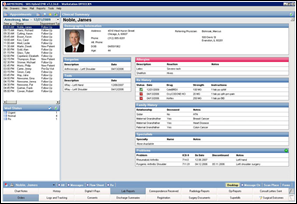Intelligent Healthcare Information Integration 3/4/10
Meaningful Views
“Meaningful Views” is a grand conglomerate term (not to be confused with the “Meaningful Ewes” from a prior posting.) It encompasses graphical user interfaces (GUIs) and workflow efficiencies and the minimization of “clicky-clicks.” (Props to Jonathan Bush for that term; it says so much in such a cutesy, snarky way!) Meaningful views are something we all seek, every day, whether via digital dazzlery or paper and pen.
Consider the ultimate goal of medical information: to lead to better heath. My goal, as a physician, is to help my patients lead better quality lives via better health choices and illness management optimization. To accomplish this goal, I need to: obtain data; aggregate, assimilate, and evaluate that data; add interpretive value to that data; and deliver the data’s meaning and true usefulness to the patient. Whether it needs to come from the patient, from a lab test or radiology exam, or from a textbook, professor, colleague, or website, the data I need to digest must somehow be “viewed” in order to be shared and used.
While auditory “viewings” of data are important, more and more in our modern world we are turning to visual information sharing portals. Televisions, faxes, lab/radiology printouts, computer screens – these are increasingly diminishing the verbal-auditory transfer of information.
The exponential growth rate of medical knowledge has long ago exceeded the mental capacity of mere mortals. Thus, how data is presented has become increasingly pressing. We need data views that facilitate our data comprehension. If we were not mere mortals – and perhaps the ultimate goal of all this techno-data-collaboration is to allow this – we could share knowledge via some form of Vulcan mind meld or Borgian collective consciousness. Until that time, in order for us to share the information we seek or need, the presentation of that data must improve.
Face it: we all only have so much time in a day. We need data delivery which is as fast as possible, as efficient as possible, and as easy to assimilate as possible, because we have a lot of things we need to do with that data. Personally, I also want to get home to see my family on occasion. (OK, I also want to have time to catch the latest Mythbusters.)
I want data “views” that make sense. I want data views where I have to do as little as possible to assimilate said data. I want views that allow me to do the things I really want to do, not views that require me to alter what I do in order to accommodate the viewing. If I have to learn how to view the data, if I have to work to visualize the data because it comes in a difficult format, if I have to constantly seek the data I need because it comes in non-standard views, then the data viewing becomes a barrier to my goals.
Workflow efficiency is enhanced by standardized patterns. In my office, for example, each exam room is set up identically and all of the necessary supplies are stored in identical locations within each room. I don’t have to spend any mental energy deciding which room I’m in and where the tongue blades are stored. I can spend that energy thinking about and talking with my patients. It’s little, but it adds up.
When I seek data from a lab report or from a radiology report or from the exam notes of a previous physician, you know where most of my time is spent? Yep. Looking for the data I need. Why? Because the “view” is either non-standard, sub-standard, or, sometimes, flat out crappy.
I recently learned of an initiative to provide cross-platform standardization of laboratory data. This means that whenever I look at a lab report, from whichever institution or provider or EMR or HIE, the data is presented in a regular, logical, and consistent format. The “view” is optimized. Time is spent in understanding the data, not in finding the data. (If you’ve ever had a new lab reporting system thrust upon you where you had to relearn where to look for lab data in the new system’s report forms, you’ll understand). If you can easily see it, you can use it. If you can easily see it, you won’t unnecessarily repeat it. If you can easily see it, you can make meaning from it.
Meaningful use, in my humble opinion, should always revolve about what helps us help patients. Help me spend less time looking for what I need, help me focus less upon data entry functions and clicky-clicks, help me make better decisions for helping more people faster, help me get home to see my wife, sons, and Survivor more often – that is meaningful use for a trench grunt. This standardized look for lab reports, one form of “meaningful views,” would be a great step in that direction.
From the trenches…
“Know where to find the information and how to use it. That’s the secret of success." – Albert Einstein

Dr. Gregg Alexander, a grunt in the trenches pediatrician, directs the “Pediatric Office of the Future” exhibit for the American Academy of Pediatrics and is a member of the Professional Advisory Council for ModernMedicine.com. More of his blather…er, writings…can be found at his blog, practice web site or directly from doc@madisonpediatric.com.










The article about Pediatric Associates in CA has a nugget with a potentially outsized impact: the implication that VFC vaccines…